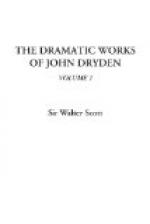The “Rival Ladies,” acted in 1663, and published in the year following, was our author’s next dramatic essay. It is a tragi-comedy; and the tragic scenes are executed in rhyme,—a style which Dryden anxiously defended, in a Dedication addressed to the Earl of Orrery, who had himself written several heroic plays. He cites against blank verse the universal practice of the most polished and civilised nations, the Spanish, the Italian, and the French; enumerates its advantages in restraining the luxuriance of the poet’s imagination, and compelling him to labour long upon his clearest and richest thoughts: but he qualifies his general assertion by affirming, that heroic verse ought only to be applied to heroic situations and personages; and shows to most advantage in the scenes of argumentation, on which the doing or forbearing some considerable action should depend. Accordingly, in the “Rival Ladies,” those scenes of the play which approach to comedy (for it contains none properly comic) are written in blank verse. The Dedication contains two remarkable errors: The author mistakes the title of “Ferrex and Porrex,” a play written by Sackville Lord Buckhurst, and Norton; and he ascribes to Shakespeare the first introduction of blank verse. The “Rival Ladies” seems to have been well received, and was probably of some advantage to the author.
In 1663-4, we find Dryden assisting Sir Robert Howard, who must be termed his friend, if not his patron, in the composition of a rhyming play, called the “Indian Queen.” The versification of this piece, which is far more harmonious than that generally used by Howard, shows evidently, that our author had assiduously corrected the whole play, though it may be difficult to say how much of it was written by him. Clifford afterwards upbraided Dryden with having copied his Almanzor from the character of Montezuma;[11] and it must be allowed, there is a striking resemblance between these two outrageous heroes, who carry conquest to any side they choose, and are restrained by no human consideration, excepting the tears or commands of their mistress. But whatever share Dryden had in this piece, Sir Robert Howard retained possession of the title-page without acknowledgment, and Dryden nowhere gives himself the trouble of reclaiming his property, except in a sketch of the connection between the “Indian Queen,” and “Indian Emperor,” where he simply states, that he wrote a part of the former. The “Indian Queen” was acted with very great applause, to which, doubtless, the scenery and dresses contributed not a little. Moreover, it presented battles and sacrifices on the stage, aerial demons singing in the air, and the god of dreams ascending through a trap; the least of which has often saved a worse tragedy.




